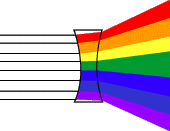Lenses
Most of the light that reaches our eyes is reflected off of objects to produce the images that we see. The speed that light travels at is generally constant; however, when it moves through a material with a different density, the speed will vary. Light travels faster through materials that are less dense. This causes refraction, or bending, of light rays to occur when they meet the surface of a different medium. The larger the angle of refraction, the more the light is bent.
Lenses are pieces of transparent material that are able to refract light due to one or both surfaces being curved. There are two types of lenses: concave and convex.
Convex lenses are thicker in the middle, causing the light rays to come together at a focal point. This is the shape of the lens in the eye. The thicker the middle of the lens, the more the light is bent making the focal distance shorter.

Convex Lens. Courtesy of howthingswork.com.
Concave lenses are thicker on the outside than in the middle. This causes the light rays to spread out rather than converge at a focal point. Therefore, concave lenses prevent light from focusing, making the focal distance longer.

Concave Lens. Courtesy of howthingswork.com.